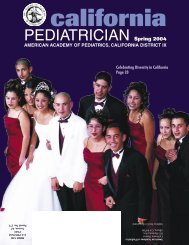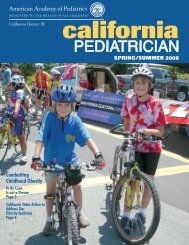PEDIATRICIAN Spring 2003 - AAP-CA
PEDIATRICIAN Spring 2003 - AAP-CA
PEDIATRICIAN Spring 2003 - AAP-CA
You also want an ePaper? Increase the reach of your titles
YUMPU automatically turns print PDFs into web optimized ePapers that Google loves.
Culturally Appropriate Communication Is<br />
Good Medical Practice<br />
Allan Lieberthal, M.D., F<strong>AAP</strong><br />
California is the most culturally<br />
diverse state in the country. Fortyseven<br />
percent of the population<br />
is white, 32 % Hispanic, 12 % Asian and<br />
Pacific Islander, 7 % African American, and<br />
1% Native-American. As many as 46% of<br />
the population has Limited English Proficiency<br />
(LEP). Over 100 languages are spoken<br />
including, in addition to English and Spanish,<br />
Tagalog, Armenian, Chinese, Thai, Korean,<br />
Arabic, Vietnamese, Hebrew, Russian, Farsi,<br />
and Hindi. We, as pediatricians, face a constant<br />
challenge to communicate with our patients<br />
and parents effectively. Many of us speak<br />
Spanish or another language, in addition to<br />
English. Some of us are fluent in that language<br />
while others try to get by with limited fluency.<br />
We are used to getting by with interpretation<br />
by children, friends, other parents, or a combination<br />
of the parent’s limited English and what<br />
little we may know of their primary language.<br />
The consequence may be that important information<br />
is miscommunicated or omitted during<br />
the medical encounter.<br />
A recent article in Pediatrics 1 points out<br />
the pitfalls of inadequate interpretation. In a<br />
sample of 13 encounters, six with a hospital<br />
interpreter, six with ad-hoc interpreters and one<br />
with an 11-year-old child interpreting, there<br />
were an average of 31 errors per encounter.<br />
Seventy-seven precent of errors made by the<br />
ad hoc interpreters and the child had clinical<br />
significance. This was significantly more than<br />
the 53% of clinically important errors made by<br />
the hospital interpreters. Errors included omission,<br />
false fluency, substitution, and addition.<br />
Recognizing that poor communication<br />
results in inferior medical care, the federal government<br />
has set standards for Culturally and<br />
Linguistically Appropriate Services (CLAS)<br />
(www.hhs.gov/ocr/lepfinal.htm). Standards<br />
published by the Department of Health and<br />
Human Services (HHS), Office of Civil Rights<br />
(OCR) apply to covered entities that include<br />
“any state or local agency, private institution<br />
or organization, or any public or private individual<br />
that operates, provides or engages in<br />
health, medical or social service programs that<br />
receive or benefit from HHS assistance.” The<br />
federal CLAS standards require covered entities<br />
to identify the language needs of patients<br />
and to provide proficient interpretation in a<br />
timely manner. At the state level, Assembly<br />
Bill 292 (Yee) has been introduced and, if<br />
passed and signed into law, would prohibit the<br />
use of children as interpreters.<br />
There are many approaches to providing<br />
adequate interpreter services. Kaiser-Permanente<br />
in Panorama City has introduced a prototype<br />
program to comply with the standards.<br />
Employees who serve as interpreters must pass<br />
the language proficiency test for interpretation.<br />
These are mostly Spanish speakers. We rarely<br />
have interpreters available for the many other<br />
languages we encounter in our multi-ethnic<br />
practice. In order to meet the needs of all of<br />
our LEP patients, patients are identified as<br />
needing interpretation at the time of making<br />
an appointment and at check-in. A printed<br />
area on the registration papers indicates the<br />
preferred language of the patient and whether<br />
interpretation services are needed. If there is no<br />
interpreter available, we are using Language<br />
Line Services (www.languageline.com), a<br />
telephone-based service that can provide interpretation<br />
in over 140 languages. This can be<br />
done in the exam room using a pair of portable<br />
phone extensions, one for the patient/parent<br />
and one for the physician. The process requires<br />
only a small increase in time as compared to<br />
having an interpreter on site.<br />
Shortly after the Language Line Service<br />
was in place, I was seeing one of my Armenian<br />
patients whose mother speaks very limited<br />
English. It appeared to be a routine sick visit.<br />
Through halting English, I understood the<br />
symptoms of a common cold, but felt a little<br />
uneasy because the mother did not appear to<br />
understand my English instructions. I tried the<br />
Language Line and soon found out that I had<br />
totally misunderstood the illness. In fact the<br />
child had a history consistent with cough variant<br />
asthma. Had I been forced to communicate<br />
in English, I am sure the mother would not<br />
have understood my explanation and instructions.<br />
Using the Language Line it was easy<br />
Over 100 languages are spoken including, in addition to English<br />
and Spanish, Tagalog, Armenian, Chinese, Thai, Korean, Arabic,<br />
Vietnamese, Hebrew, Russian, Farsi, and Hindi.<br />
to get a good history and to explain what her<br />
child had since she was hearing it in her own<br />
language. The mother, who I had seen on several<br />
previous occasions without interpretation<br />
services, was effusive in thanking me and telling<br />
me how happy she was with the visit. From<br />
initial skepticism, I became a convert.<br />
Unlike pediatricians in private practice<br />
or in network managed care practices, I do not<br />
have to deal directly with the cost and reimbursement<br />
for interpretation services. This is<br />
especially important for doctors practicing in<br />
poor communities with a high percentage of<br />
ethnic minorities. Use of the Language Line<br />
may cost as much as $15 for a 10 minute visit.<br />
If a practice has a large number of patients<br />
requiring interpretation by a nurse, workflow<br />
may be impaired or additional personnel may<br />
be needed. This should be recognized as an<br />
additional expense and must be reimbursed<br />
appropriately.<br />
Even consistent professional interpreter<br />
service will not bring us to a single standard<br />
of medical care. The reality is that there is a<br />
severe shortage of qualified health professionals<br />
in all minority groups. Until our patients<br />
can receive competent care from clinicians<br />
who share their culture and language, we must<br />
do our best to be sensitive and responsive to<br />
their needs.<br />
REFERENCE<br />
1. Flores G, Laws B, Mayo SJ, et. al. Errors<br />
in medical interpretation and their potential<br />
clinical consequences in pediatric emergencies<br />
Pediatrics <strong>2003</strong>(1):111:6-14<br />
<strong>CA</strong>LIFORNIA <strong>PEDIATRICIAN</strong> — SPRING <strong>2003</strong>/ 5








